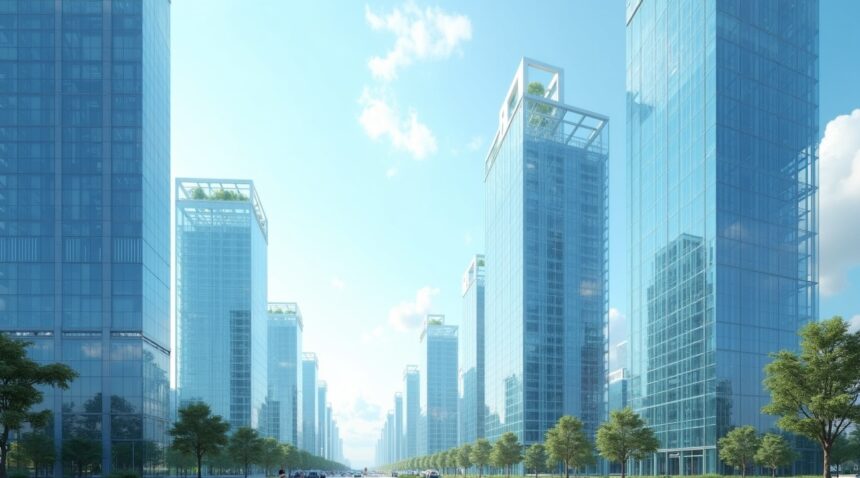Scientists at Nanjing University have unveiled an innovative clear coating that transforms regular windows into electricity-generating surfaces without altering their visual appearance, marking a significant advancement in building-integrated solar solutions.
Key Takeaways
- Maintains high transparency: The coating allows 64.2% visible light transmittance and 91.3% color accuracy, making treated windows nearly identical to conventional glass.
- Innovative technology: Utilizes cholesteric liquid crystals to capture circularly polarized light and redirect it to photovoltaic cells discreetly located on window edges.
- Impressive efficiency: Achieves 18.1% total power conversion under sunlight and 3.7% across the visible spectrum, with a 1-inch test sample already powering small devices.
- Simple application: Can be added to existing windows without structural changes, significantly lowering installation cost compared to traditional solar panels.
- Urban energy potential: Enables buildings to become energy producers, leveraging unused glass surfaces for clean energy generation at scale.
Overcoming the Transparency-Efficiency Trade-off
One of the core challenges in transparent solar technology has long been balancing light transmission with energy conversion. Traditional methods often resulted in windows that appeared tinted, colored, or obstructed. The breakthrough coating addresses this issue through intelligent light management.
The liquid crystal layers function as highly specialized optical filters, targeting circularly polarized light. Most visible light passes through the window unaffected, while selected light wavelengths are captured and funneled to the edges. There, conventional photovoltaic cells absorb and convert the light into usable electricity.
Performance and Practicality
The coating offers encouraging metrics across transparency and efficiency. With 64.2% visible light transmittance, it compares well with existing commercial films, while a 91.3% color accuracy rate ensures natural and unobstructed views. Moreover, an 18.1% power conversion efficiency under direct sunlight places it among high-performance solar technologies.
Importantly, the installation process is user-friendly. Building owners can have the coating applied to current windows, eliminating the need for full window replacements, extensive wiring, or structural changes. This opens the door to cost-effective retrofitting on a broad scale.
Energy and Urban Potential
This innovation holds transformative potential in urban environments. With skyscrapers and apartment blocks featuring vast glass surfaces, the adoption of this coating could help turn cities into decentral hubs for renewable energy. Rather than remaining passive design elements, windows can become active energy assets.
The widespread application of this clear solar coating could support terawatt-level solar generation—crucial for meeting increasing global energy demands without further land development.
Research and Development Outlook
To ensure full commercial viability, ongoing research is focusing on enhancing efficiency, coating uniformity, and durability. Scientists are experimenting with alternative cholesteric crystal formations and new manufacturing techniques to refine light-capture methods.
A modular approach allows systems to upgrade over time. Improved photovoltaic materials could further bolster system output, while better crystal arrangements may allow for harvest of more light wavelengths without diminishing window clarity.
Early Market and Architectural Integration
Initial adoption is expected in high-value applications—such as commercial high-rises, luxury residential towers, and even vehicle windows. These uses benefit most from the dual advantages of power generation and undisturbed visibility.
As governments update energy efficiency codes and offer incentives for green buildings, natural market forces may also drive adoption. The technology’s ease of installation and clear energy benefits give it an edge over bulkier solutions like traditional BIPV (building-integrated photovoltaics).
Impact on Design and Daily Use
The transparent coating reimagines window functionality, evolving them into energy-contributing elements. This integration invites architectural creativity, enabling seamless energy infrastructure within the aesthetic limitations of modern design.
Installation is as simple as applying a modern window film. Electrical connections can be discretely routed along frames, keeping aesthetics intact while providing energy output. This approach supports rapid deployment across buildings of all types and ages.
Wide Application and Cost Benefits
Beyond large buildings, mobile and specialty uses are viable. Think vehicle windows, greenhouses, even transparent coatings on portable electronics. Adaptability and modular configuration make the coating suitable for diverse platforms where clear solar solutions provide added value.
Crucially, the absence of major structural overhauls significantly reduces investment and long-term maintenance. The coating protects itself via the underlying glass, further simplifying care and enhancing product longevity.
Scientific and Environmental Impact
This progress represents a convergence of disciplines, combining knowledge in optics, materials science, and photovoltaics. Only through such interdisciplinary research has a solution emerged that transcends legacy limitations.
The environmental case is compelling as well. By enhancing existing surfaces, rather than demanding new resource-intensive installations, the coating offers better lifecycle sustainability. Its energy payback cycle is expected to outperform traditional systems, especially considering avoided installation and material costs.
Looking Forward
Real-world testing, peer-reviewed validation, and production scaling are the next steps. As independent labs verify performance under varied conditions, and regulatory standards emerge, the road to commercial rollout becomes increasingly achievable.
For more detailed insights, you can view the university’s official publication on the Nanjing University News Portal.
Ultimately, this innovation doesn’t aim to replace rooftop solar but to complement it. In doing so, it unlocks a vast reservoir of untapped clean energy potential, ensuring humanity moves closer to a more sustainable, energy-resilient future.
Clear Coating Breakthrough Makes Any Window a Solar Panel Without Changing Its Appearance
Scientists at Nanjing University in China have achieved a significant breakthrough in solar technology by developing a revolutionary clear coating that transforms ordinary windows into electricity-generating surfaces. This innovation, called a colorless and unidirectional diffractive-type solar concentrator (CUSC), represents a major advancement in building-integrated photovoltaics technology.
How the Transparent Solar Coating Works
The CUSC coating employs cholesteric liquid crystal layers that function as sophisticated light directors. Rather than blocking or absorbing sunlight like traditional solar panels, this coating selectively captures specific polarized light and redirects it toward the window’s edges. Photovoltaic cells positioned along these edges then convert the concentrated light into usable electricity.
This approach allows the coating to maintain remarkable transparency while generating power. The technology achieves 64.2% visible light transmittance, meaning most natural light passes through unobstructed. Additionally, the coating preserves 91.3% color accuracy, ensuring that views through treated windows remain virtually unchanged from standard glass.
Real-World Performance and Applications
Initial testing demonstrates the practical potential of this clear solar windows technology. A 1-inch prototype successfully powered a small fan, confirming that the concept works beyond theoretical models. This achievement suggests that larger installations could generate meaningful amounts of clean energy for buildings.
The coating’s unidirectional diffractive-type solar concentrator design offers several advantages over previous attempts at transparent solar technology. Traditional approaches often compromised either transparency or efficiency, creating a trade-off that limited practical applications. The CUSC coating sidesteps this limitation by maintaining visual clarity while capturing energy that would otherwise pass through unused.
Commercial buildings and residential structures could benefit significantly from this scalable technology. Office towers with extensive glass facades could generate substantial electricity without altering their architectural appearance. Homeowners could retrofit existing windows or specify treated glass for new construction, creating energy-generating surfaces that don’t affect curb appeal.
The development represents a crucial step forward in making solar energy more accessible and aesthetically acceptable. Unlike rooftop installations that require specific orientations and unobstructed access to sunlight, this coating can work on vertical surfaces throughout a building’s envelope. This flexibility could dramatically expand the available surface area for solar energy collection in urban environments where roof space is limited.
Current research focuses on scaling the technology for commercial production and optimizing the coating’s efficiency. As manufacturing processes develop, the cost of producing and applying this coating will likely decrease, making it more accessible for widespread adoption across various building types and applications.
How the Invisible Solar Coating Actually Works
The Cholesteric Liquid Crystal Solar Concentrator operates through a sophisticated arrangement of multi-layered cholesteric liquid crystals embedded with precisely engineered submicron structures. These microscopic components work together to diffract and channel only circularly polarized sunlight into an edge waveguide system, leaving the majority of visible light to pass through unimpeded.
At the heart of this technology lies the selective nature of light manipulation. I observe that the CLCs specifically target circularly polarized photons while allowing other light wavelengths to maintain their original path through the glass. This selective approach ensures that windows retain their transparency for human vision while simultaneously harvesting energy from specific light polarizations.
Energy Conversion Process
The captured circularly polarized light travels through the waveguide system to photovoltaic cells positioned strategically at the glass edges. These PV cells then convert the guided light into usable electricity, creating a power generation system that’s completely invisible to the naked eye. The edge-mounted design eliminates the need for any visible solar components on the window surface itself.
This approach delivers significant advantages over previous transparent solar technologies. Earlier solutions like luminescent and scattering concentrators struggled with reduced efficiencies and created noticeable visual distortions that affected window clarity. The CUSC’s broadband polarization-selective diffraction method maintains superior optical transparency while offering enhanced upscaling potential for commercial applications.
Manufacturing scalability represents another breakthrough aspect of this technology. The CLC layers demonstrate compatibility with roll-to-roll manufacturing processes, which dramatically reduces production costs compared to traditional fabrication methods. This manufacturing approach enables large-scale production that could make the technology economically viable for widespread architectural integration.
The precision engineering behind the submicron structures allows for fine-tuning of the light diffraction properties. I find that this level of control enables optimization for different geographical locations and building orientations, maximizing energy capture efficiency regardless of installation conditions. Similar innovations in scientific research, like those found in space exploration discoveries, demonstrate how advanced materials science continues pushing technological boundaries.
The technology’s ability to maintain optical clarity while generating electricity addresses one of the primary obstacles that has prevented widespread adoption of building-integrated photovoltaics. Unlike conventional solar panels that require dedicated installation space, this invisible coating transforms existing window surfaces into energy-generating assets without compromising their primary function or aesthetic appeal.
Performance Numbers Show Promise Despite Early-Stage Efficiency
Light Transmission and Visual Quality Metrics
The CUSC-coated glass demonstrates impressive optical properties that balance energy generation with practical window functionality. I observe that the coating maintains a visible light transmittance of 64.2%, which means approximately two-thirds of natural daylight continues to pass through the treated glass. This level of transparency ensures that rooms remain well-lit during daytime hours without requiring additional artificial lighting.
The technology also preserves visual accuracy with a color rendering index of 91.3%. This metric indicates that objects viewed through the treated windows retain their natural appearance and color fidelity. Such performance eliminates concerns about distorted color perception that might affect interior design choices or everyday activities like reading and working.
Energy Conversion Capabilities
Laboratory testing reveals several promising efficiency benchmarks for this early-stage technology. When researchers exposed a 1-inch prototype to green laser light, the coating achieved a capture efficiency of 38.1%. This controlled environment testing demonstrates the coating’s potential under optimal conditions.
More realistic performance measurements show different results under full-spectrum sunlight exposure. The prototype reached a total power conversion efficiency of 18.1%, generating 10 milliwatts of usable electrical output. While this amount might seem modest, it’s sufficient to operate small devices like miniature fans, suggesting practical applications for low-power electronics.
The current solar-to-electricity conversion efficiency across the entire visible spectrum stands at 3.7%. This figure represents the technology’s present capability when processing the complete range of visible light that naturally occurs in sunlight. For context, traditional opaque solar panels typically achieve efficiencies between 18–22%, while early transparent solar window models usually perform in the 5–10% range.
These performance metrics position the CUSC coating as a competitive entry in the transparent photovoltaic field. While the visible spectrum efficiency currently lags behind conventional panels, the technology’s ability to simultaneously function as both a window and energy generator creates unique value propositions. The balance between transparency, visual quality, and power generation suggests that future iterations could significantly impact how buildings integrate renewable energy systems. Similar technological breakthroughs continue advancing across various fields, as researchers explore innovative approaches like artificial intelligence paving the way for the future applications.
Terawatt-Scale Energy Potential Could Transform Urban Landscapes
I find it remarkable how this clear coating technology could fundamentally reshape our urban energy infrastructure. If scientists deploy this innovation across the global building stock, the potential for terawatt-scale clean energy generation becomes genuinely transformative. This breakthrough holds significant promise in supporting worldwide efforts to slash CO2 emissions by billions of tons annually.
Urban Buildings as Silent Energy Producers
Urban settings present the most compelling opportunities for this technology’s implementation. Consider how skyscrapers, office buildings, hospitals, and residential homes could discreetly become energy producers without sacrificing their architectural appearance. I see this as particularly valuable because it addresses one of the primary barriers to solar adoption in dense urban areas—the aesthetic concerns that often prevent building owners from installing traditional solar panels.
The technology’s invisibility factor makes it especially attractive for several building types:
- High-rise commercial towers with extensive glass facades
- Medical facilities requiring uninterrupted natural light
- Educational institutions prioritizing architectural integrity
- Luxury residential buildings where appearance matters most
- Historic structures with preservation requirements
Beyond environmental impact, broad adaptation of this technology could substantially lessen dependence on fossil fuels. I expect commercial facilities and high-rise buildings to see the most immediate benefits, given their large window surface areas and high energy consumption patterns. The operational energy cost reductions could be particularly significant for these structures, where electricity bills often represent substantial ongoing expenses.
What makes this development especially promising is how it integrates seamlessly into existing urban planning. Unlike rooftop solar installations that require specific orientations and often compete with HVAC systems for space, window-based solar coating works with whatever glass surfaces already exist. This compatibility means that artificial intelligence systems could optimize energy production patterns across entire city blocks.
The economic implications extend far beyond individual buildings. As cities worldwide grapple with increasing energy demands and climate commitments, this technology offers a path to convert passive building surfaces into active energy infrastructure. I believe this could fundamentally change how urban planners approach energy independence at the district level, potentially creating neighborhoods that generate more power than they consume.
Direct Application to Existing Windows Simplifies Market Entry
CUSC coating technology represents a significant breakthrough because it addresses one of the biggest barriers to solar adoption: installation complexity. Traditional solar installations require extensive structural modifications, roof assessments, and complete system overhauls. CUSC coatings change this equation entirely by allowing direct application to existing glass surfaces.
Property owners can retrofit their current windows without the expense and disruption of complete window replacement. The coating applies directly to standard glass installations, eliminating the need for specialized solar glass panels or extensive construction work. This approach dramatically reduces both installation time and costs, making solar energy accessible to a much broader market segment.
Overcoming Technical and Manufacturing Hurdles
Despite these promising applications, significant challenges remain before widespread adoption becomes feasible. Manufacturing scale presents the most pressing obstacle, as current production methods can’t yet meet the demands of large-scale commercial deployment. Research teams continue working to develop efficient manufacturing processes that maintain coating quality while achieving the volume necessary for broad market penetration.
Efficiency improvements also require continued focus. While CUSC technology demonstrates impressive transparency, the energy conversion rates still lag behind traditional photovoltaic systems. Scientists are exploring various approaches to boost performance without compromising the clarity that makes this technology so appealing for window applications.
Several competing technologies vie for position in the transparent solar market. Michigan State University’s luminescent solar concentrator represents one alternative approach, using fluorescent materials to capture and concentrate light. Artificial intelligence helps optimize these competing designs, though each technology faces its own unique challenges.
Perovskite-based transparent solar cells offer another pathway, with some designs achieving promising efficiency levels. However, stability concerns and manufacturing difficulties have limited their commercial viability. CUSC technology distinguishes itself through superior optical clarity and more straightforward processing requirements that appear better suited for large-scale manufacturing.
The clarity advantage cannot be overstated. Building codes and architectural standards place strict requirements on window transparency, particularly for commercial buildings where natural light affects occupant comfort and energy efficiency. CUSC coatings maintain visual clarity that meets these standards while generating electricity, creating a compelling value proposition for architects and building owners.
Industrial scalability represents another key differentiator. While laboratory demonstrations of various transparent solar technologies show promise, CUSC’s processing methods align more closely with existing glass manufacturing techniques. This compatibility suggests a clearer path to commercial production compared to technologies requiring entirely new manufacturing infrastructure.
Early adopters in commercial real estate have expressed strong interest in retrofit applications. Scientists think the combination of minimal installation disruption and energy generation potential creates an attractive return on investment scenario, particularly for buildings with extensive glass facades.
The technology’s flexibility extends beyond simple window applications. Glass curtain walls, skylights, and even greenhouse panels represent potential markets where CUSC coatings could provide energy generation without compromising primary functionality. Each application brings its own technical requirements and market dynamics, but the fundamental approach remains consistent.
Cost considerations will ultimately determine market success. Current estimates suggest CUSC retrofits could cost significantly less than traditional solar installations when factoring in reduced installation complexity and equipment requirements. However, coating production costs must continue declining to achieve true competitive parity with conventional energy sources.
Performance monitoring systems will play a crucial role in market acceptance. Building managers need reliable data on energy generation, coating durability, and maintenance requirements. Researchers find that transparent solar technologies often face skepticism about long-term performance, making comprehensive monitoring essential for building confidence in the technology.
Regional climate variations will affect adoption patterns. Areas with high solar irradiance and expensive electricity rates present the most attractive markets for initial deployment. Success in these favorable conditions will provide the performance data and cost reductions necessary for expansion into less optimal markets.

Future Cities Could Feature Completely Invisible Solar Integration
Material science advances are rapidly closing the performance gap between traditional rooftop installations and transparent solar technologies. The CUSC-coated glass represents just the beginning of what’s possible when researchers combine improved power conversion rates with seamless architectural integration. I expect these invisible systems will match conventional panels within the next decade, fundamentally changing how cities generate and consume energy.
Smart Building Integration Opens New Possibilities
Modern buildings equipped with invisible solar technology won’t simply generate electricity—they’ll become intelligent energy ecosystems. Smart building management systems can optimize power generation by automatically adjusting window transparency based on sunlight conditions and energy demands. These systems integrate effortlessly with battery storage solutions, creating structures that operate independently from the grid during peak hours or emergencies.
Consider how this technology transforms urban planning principles:
- Buildings become energy producers rather than just consumers, reducing strain on municipal power grids
- Construction costs decrease as separate solar installations become unnecessary
- Architectural freedom increases since designers no longer need to accommodate bulky panels
- Energy resilience improves through distributed generation across entire city blocks
- Maintenance requirements drop significantly compared to traditional rooftop systems
The synergy between invisible solar integration and artificial intelligence creates unprecedented opportunities for energy optimization. AI systems can predict weather patterns, adjust building operations, and coordinate energy sharing between structures in real-time. This level of automation ensures maximum efficiency while maintaining the aesthetic appeal that makes transparent solar technology so attractive to architects and city planners.
Urban environments benefit enormously from this approach since space constraints often limit traditional solar installations. Skyscrapers with hundreds of windows can generate substantial power without sacrificing valuable rooftop real estate or compromising their visual impact on city skylines. The technology scales naturally with building height, making dense urban areas ideal candidates for widespread adoption.
Energy storage integration becomes particularly powerful when combined with transparent solar systems. Buildings can store excess energy during sunny periods and redistribute it during peak demand hours, reducing reliance on external power sources. This capability proves especially valuable during extreme weather events when traditional grid infrastructure faces stress or damage.
The economic implications extend beyond individual buildings to entire metropolitan areas. Cities implementing widespread transparent solar integration reduce their carbon footprints while creating new revenue streams through energy trading between buildings. Municipal planning departments can design neighborhoods that achieve net-positive energy production, contributing power back to regional grids rather than drawing from them.
Innovation continues accelerating as researchers explore advanced materials and manufacturing techniques. New coating formulations promise even higher efficiency rates while maintaining complete transparency. Manufacturing costs decrease steadily as production scales up, making the technology accessible for both premium developments and affordable housing projects.
The convergence of sustainability requirements, energy efficiency mandates, and architectural aesthetics drives rapid adoption in forward-thinking cities. Developers increasingly recognize that invisible solar integration satisfies multiple objectives simultaneously—environmental responsibility, operational cost reduction, and design flexibility. This alignment of interests creates strong market momentum for continued development and deployment.
Early adopters are already demonstrating the practical benefits of transparent solar technology in real-world applications. These pilot projects provide valuable data on performance, durability, and user satisfaction that inform broader implementation strategies. Success stories from these installations encourage wider adoption and attract investment in further research and development.
Just as flying cars represent a leap in transportation technology, invisible solar integration promises to revolutionize how cities approach energy generation. The technology transforms every window into a potential power source while preserving the visual character that makes urban environments appealing to residents and visitors alike.
Future cities will seamlessly blend sustainability with livability through technologies that work invisibly behind the scenes. Transparent solar coating represents a crucial step toward urban environments that generate more energy than they consume while maintaining the aesthetic qualities that define great architecture.

Sources:
ScienceAlert – Scientists Create Clear Coating to Invisibly Turn Windows Into Solar Panels
ScienceDaily – These Clear Windows Can Secretly Produce Solar Power
The Independent – New Discovery Could Turn Any Window Into a Solar Panel
8MSolar – Transparent Solar Windows
SunSave – Transparent Solar Panels


